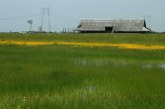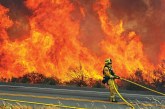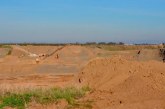by Shawn Smallwood –
I don’t know why the Transmission Agency of Northern California’s (TANC) project collapsed, but I do suspect scrutiny of the project, had it continued, would have surprised folks even more than the project’s arrival or its demise. The project’s goal was to bring renewable energy to our region from northeastern California – sounds good, so far – but TANC didn’t say much about the renewable energy they’d be delivering, or the likely project impacts or alternatives.
The California Public Utilities Commission (CPUC) initiated hearings on 33% RPS implementation, the California Energy Commission (CEC) prepared studies, and the California Air Resources Board (CARB) prepared the only California Environmental Quality Act (CEQA) review of the impacts of the 33% RPS. The CARB completed the CEQA review before I was aware they were preparing it, and the resulting EIR fell far short of adequately addressing the impacts or alternatives. From all these hearings, studies, and veiled CEQA review, wind power emerged as the darling renewable energy source, thus setting the stage for transmission line proposals.
Commercial wind energy generation requires transmission lines. Most primary wind resource areas occur far from “load demand,” which is where people live and work in cities and towns. Solar farms also require transmission, but developers enjoy more flexibility over solar farm siting, so can more readily select sites near existing transmission lines. Wind farm developers, on the other hand, usually have no choice but to build transmission from wind resource area to the consumer. At the other end of the spectrum from wind energy, distributed generation, mostly consisting of rooftop and blacktop solar, requires little if any transmission because the energy is generated right at load demand.
Wind energy also requires vast areas of wildlife and plant habitats. Assuming wind turbines will generate half the energy needed to close the renewable resource gap that exists between current levels of renewable energy use and the level of the 33% RPS in 2020, wind turbines would need to be installed on about 2,400 square miles of primary wind resource area. However, I don’t think California has this much terrestrial (as opposed to offshore) wind resource area, so having to install turbines in secondary wind resource areas such as in northeast California, we would see wind turbines installed on about 5,000 square miles. For perspective, I suggest visiting the hills west of Rio Vista – the Solano Wind Resource Area surrounding Bird’s Landing – to see the size of the wind turbines I’m talking about, and imagine them installed on thousands of square miles. On a clear day, one can ride a bike to the southern outskirts of Davis to see the Solano turbines, whose supporting towers alone stand 300 feet tall.
Assuming solar generated half the energy needed to close the renewable resource gap, solar arrays would need to cover about 340 square miles, which is a large area, but not nearly as large as the area needed for wind energy. State agencies, utilities, and power companies have been favoring solar farms over distributed generation due to lower costs. The costs considered, however, are only short-term costs, framed narrowly. Most Parties to the CPUC hearings don’t want to discuss the environmental impacts of covering the Mojave Desert and Carrizo Plain with solar arrays.
I’ve been attending CPUC hearings on the 33% RPS and related proceedings as an active Party to the proceedings. Prior to attending these hearings, I assumed that serious policy matters such as energy generation and distribution must be supported scientifically, so I was surprised by what passes as science in the proceedings. Central to the proceedings have been cost estimates related to alternative energy portfolios leading to the Governor’s goal. However, these cost estimates lack error terms or confidence limits, are derived from unrealistic assumptions, and from simulation models using data collected over time spans much too short to represent the variation a scientist should expect over five, ten, and twenty years. There’s no peer review and little if any consideration of the scientific literature.
Those who lead the proceedings don’t mention energy conservation as an alternative, nor do they mention cumulative effects. They neglect environmental impacts, and how these impacts will cost society in the long-term. Whenever I raise these issues, other Parties to the proceedings treat me like I’m in the wrong room. And I suppose I am in the wrong room, because I don’t see many other scientists in that room. There’s no University presence, and nobody else who performs scientific research, as far as I’m aware. Following one of my annoying questions about the environmental consequences of golden eagle collisions with wind turbines, an industry lobbyist remarked that since the Governor’s Executive Order, “the train has left the station, so get on board or…” yeah, I get the message.
The Governor’s train, however, is running over thousands of birds and hundreds if not thousands of bats every year. The Altamont Pass Wind Resource Area, situated between Tracy and Livermore, annually kills 65 golden eagles, about 400 red-tailed hawks, hundreds of burrowing owls, and >2,200 raptors of all kinds and >9,000 birds of all kinds, and all it generates for these death rates is <1% of the renewable energy generation the Governor ordered by 2020. Not one fine has been levied against the wind companies killing all these birds, most of which are protected by the Migratory Bird Treaty Act and other environmental laws. Can you imagine the bird impacts that would be caused by expanding wind power generation 10-fold? 100-fold?
California lacks sufficient terrestrial wind resource, so utility companies are looking to buy wind energy from out of state, where environmental laws are lax compared to CEQA. I believe this was the real reason behind the TANC Transmission project. I believe it was going to northeastern California, en route to the large wind farms under development in Oregon and Washington. Continued scrutiny of the TANC Transmission project would have revealed this possibility, along with estimates of thousands of birds and bats we’d have to kill every year in order to feel green about our energy use.
Within California, wind project EIRs are being certified despite findings of unavoidable, significant impacts to protected birds, relying on Statements of Over-riding Consideration which cite the Governor’s Executive Order. The CPUC is currently considering the Tehachapi Transmission Line, proposed solely to expand the Tehachapi Pass Wind Resource Area from 700 to 4,500 megawatts of installed capacity. Based on available fatality rate estimates, the expanded Tehachapi wind farm might kill about 6,500 raptors annually. For perspective, an equivalent capacity of distributed generation would kill no raptors. Not all renewable energy has the same impacts. We have choices.
As we attempt to transition from fossil fuels to renewable energy generation, wouldn’t it make sense for Californians to be informed and engaged in the decision over how to make this transition? Policy-makers and the public ought to know the long-term costs, the environmental consequences, and the scientific foundation of renewable energy alternatives. However, I’ve yet to see the news media covering the CPUC hearings. In one hearing there was an entire row of chairs reserved for the news media, but none taken. Unless the public starts taking these proceedings more seriously, California’s energy future will remain chaotic and misdirected, and we’ll find ourselves wondering 20 years from now why we still don’t have solar panels on our rooftops and why aren’t we seeing eagles anymore?
Shawn Smallwood is a self-employed ecologist who consults, performs research, and provides expert testimony for a variety of clients on endangered species issues and issues involving wildlife interactions with energy and transportation infrastructure, hazardous waste management, and agriculture. He earned his Ph.D. at UC Davis in 1990.






As usual, Shawn’s concise analysis is right to the point. Additionally, the huge for-profit energy corporations and conglomerates that bestride the land want to maintain their market monopoly of production and transmission to keep smaller local or regional community non-profit systems from enlarging (remember how PG&E fought to defeat Yolo County joining SMUD) or emerging. Community run public power is anathema to corporate CEOs who must return profits to shareholders who may reside any where worldwide.
It is clear that there really is no “free lunch” in the area of energy production. Biodisel and ethanol, once the “silver bullet” now seem to do more harm than good. My fantasy is solar panals over every parking lot and highway, but friends who know more than I do tell me it is indeed a fantasy. Despite the problems with the alternatives, though, the price of pumping unlimited carbon from oil and natural gas into the air will be higher. There! I’ve had my daily rant and feel better.
Shawn, thanks for the excellent analysis. All of us should try to use energy from clean, renewable sources as close to home as possible. The transmission line project was all negative, and smacked of Jurasic Age thinking.
I think the transmission line project was just about the availability of federal stimulus money, which is why it was put together with too much haste. I don’t really see it as Jurasic Age thinking though.
Other than rooftop solar, which tends to be more expensive than central station solar, it’s not realistic to have signifantly more renewable energy production, without building new transmission lines. That is the case all over the country, not just in California. Increasing wind energy production will definitely require many miles of new transmission lines. I’m fully supportive of renewable energy expansion, and personally prefer it to be rooftop solar first. Any type of renewable expansion will lead to considerably higher electricity rates. As Shawn points out, there are trade-offs to all the solutions. Of course, conservation and curbing demand is still the best solution of all.
First of all, I would like to remind everyone that SMUD was very much a part of the whole TANC debacle!
Secondly, we need to be careful (as the author so carefully lays out) what we wish for. The whole “wind is the only answer” or “solar is the total answer” thing reminds me of what has happened in regard to the use of plastic bags. Environmentalists whined about the use of paper bags, bc it was “killing trees”. Now environmentalists are whining that plastic bags are “killing our planet”.
We need to 1) stop and think before we do; 2) possibly use a mix of energy sources where appropriate. This would include oil drilling in the U.S., coal, natural gas, fuel cells, nuclear, solar, wind, biofuels. Don’t try to favor one to the exclusion of every other, except to do whatever makes us independent of foreign oil. As the competition heats up, pardon the pun, eventually the right mix will bubble to the top – IF POLITICIANS AREN’T BOUGHT UP BY VARIOUS SPECIAL INTERESTS.
With research and development comes improvement of alternative fuel technologies. For instance, nuclear energy is considerably more safe now than it was many years ago. Solar technology is constantly improving. Fuel cells are an intriguing idea, and it is cutting edge technology that needs to be heavily supported.
This country needs a far reaching and sound energy policy, not a hit or miss checkerboard affair that varies from state to state where local politics reins supreme. We’ve needed this since gas lines in 1976, but not one single U.S. president since then has been willing to tackle the problem in any meaningful way.